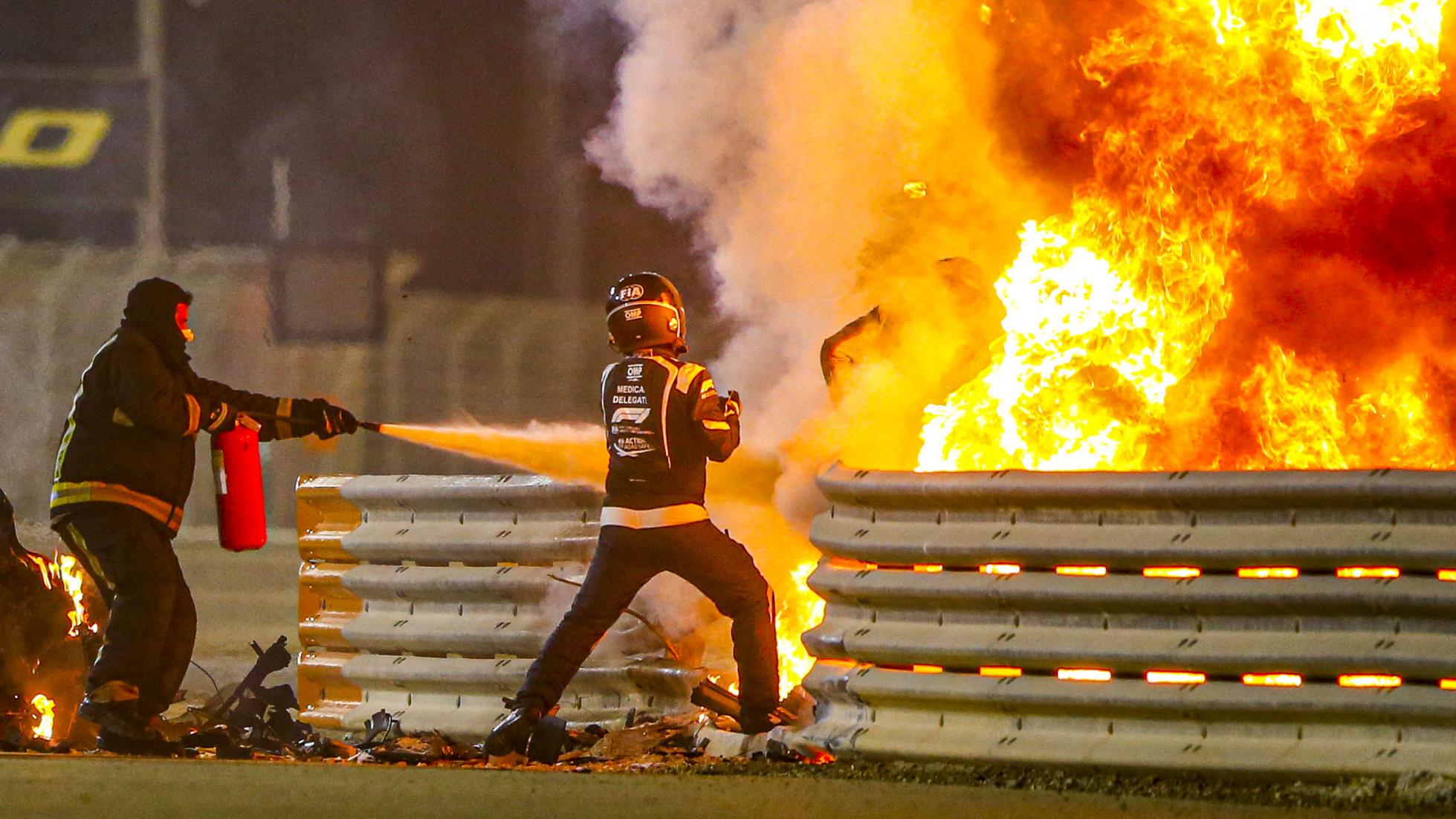How did Grosjean walk away from his terrifying F1 crash?
The HANS device
Having collided with the AlphaTauri of Daniil Kyvat, Grosjean’s car speared uncontrollably off the track on the opening lap of the 2020 Bahrain Grand Prix and impacted a metal barrier at 137mph. On-board data readings have suggested the impact force was some 51g, yet Grosjean remained conscious and was able to set about undoing his harness, removing the cockpit head restraint and jumping from the burning wreckage.
The HANS device, or Head And Neck Support will have helped protect the Frenchman from head and neck injuries during this violent deceleration. The HANS is the strapped carbon contraption you see attached to the rear of the drivers’ crash helmets, which is secured by the harness and prevents strong whiplash injuries in a crash. It’s been a mandatory safety feature in F1 since 2003.
The Halo
“I wasn’t for the halo some years ago, but I think it’s the greatest thing that we’ve brought to Formula 1, and without it I wouldn’t be able to speak with you today.”
The sobering words of Romain Grosjean himself from his hospital bed on the evening of the Bahrain Grand Prix. When the nose of his car pierced the unpadded metal barrier, the titanium halo cockpit surround parted the sections of Armco as the Haas penetrated through the structure. Had the ultra-strong halo not been present, multiple F1 experts have suggested Grosjean’s helmet would have interfaced with the barrier itself, which would likely have led to much more serious injuries.
Though the halo was scarred by the impact and the ensuing inferno, it remained structurally sound throughout the incident.

The safety cell
What made Grosjean’s accident particularly horrifying was the manner in which the car split in two after the impact. We’re used to seeing fluttering shards of carbon fibre flying from an F1 car’s various wings and aero devices when they collide, but it’s extremely rare to see the car fail structurally.
In this case, the front section of the Haas pierced the barrier at an angle, with the crash forces tearing off the rear end of the car, complete with the heavy engine and hybrid batteries. However, while the fuel system was punctured, the driver’s hugely rigid carbon fibre cockpit, known as the safety cell, remained intact and unobstructed. This meant Grosjean was given the best possible chance of an exit path from his stricken car, rather than being trapped in the fire.
Better fireproof clothing
According to footage of the accident, Grosjean freed himself from the burning car approximately 18 seconds after impact. According to ex-F1 driver and commentator Karun Chandhok, the FIA has only this year upgraded the fireproof overalls worn by the drivers, which increased their fire-resistant time from 10 to 20 seconds.
However, the drivers’ gloves are of the previous, 10-second-flameproof design, which may explain why Grosjean’s only injuries were second-degree burns to the backs of his hands.
Medical and marshal response time
The Mercedes-AMG C63 Estate that follows the F1 cars around the first lap is driven by racing driver Alan van der Merwe and crewed by F1’s deputy medical delegate Dr Ian Roberts. While the 503bhp C63 is a fast car, it’s obviously left trailing by 1,000bhp F1 monsters. Had the crash occurred later in the lap, medical help would have taken longer to arrive.
However, Merwe halted the medical car next to the crash scene just 10 seconds after it occurred, while marshals arrived with fire extinguishers to suppress the flames just enough to help Grosjean escape. Meanwhile Dr Roberts braved the intense heat to help the shaken Frenchman over the destroyed barrier and away to safety.
Medical car driver Alan van der Merwe said: “It was a big surprise for us as well, we’ve never seen that much fire in 12 years.
“Romain started to get out of the car himself, which was pretty amazing after an accident like that. It was a relief to see he was OK.”
Dr Ian Roberts told Sky Sports: “There was just a massive flame and as we arrived, it was a very odd scene, we’d got half the car pointing in the wrong direction and then just across the barrier, a mass of heat.
“We needed some way of getting to him, and we had the marshal there with an extinguisher, and the extinguisher was just enough to get the flame away. Romain then got high enough for me to reach over and pull him over the barrier.
“Obviously he was very shaky. His visor was completely opaque and in fact, melted. I had to get his helmet off just to check that everything else was OK.”
Words: Ollie Kew
Image: LAT Motorsport images

